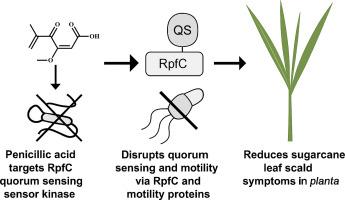Penicillic acid-mediated quorum-sensing inhibition suppresses motility and virulence of Xanthomonas albilineans
IF 4
1区 农林科学
Q2 BIOCHEMISTRY & MOLECULAR BIOLOGY
引用次数: 0
Abstract
Sugarcane leaf scald, caused by Xanthomonas albilineans, is a significant bacterial disease that poses a substantial threat to global sugar production. The quorum-sensing (QS) system in X. albilineans presents a promising target for anti-virulence strategies. Here, we demonstrate that penicillic acid exhibits potent antibacterial activity against X. albilineans, with a minimum inhibitory concentration (MIC) of 6 μg/mL and an effective concentration for 50 % inhibition (EC₅₀) of 3.703 μg/mL. Transcriptome analysis, molecular docking, and surface plasmon resonance (SPR) confirmed that penicillic acid competitively binds the sensory histidine kinase RpfC, disrupting DSF-mediated QS signaling. At sub-inhibitory concentrations (½ MIC), penicillic acid significantly suppressed twitching, swimming, and swarming motility by downregulating genes associated with type IV pili, flagellar assembly, and chemotaxis. At full MIC, direct binding of penicillic acid to the FlgE and CheW proteins further impaired motility. These findings elucidate the molecular mechanism of penicillic acid and support its potential as a quorum-sensing inhibitor for biocontrol of sugarcane leaf scald.

青霉酸介导的群体感应抑制抑制白色黄单胞菌的运动性和毒力
甘蔗叶片烫伤是由白色黄单胞菌引起的一种重要细菌性疾病,对全球食糖生产构成重大威胁。白棘球绦虫群体感应(QS)系统是一种很有前途的抗毒策略靶点。在这里,我们证明了青霉素酸对X. albilineans具有有效的抗菌活性,最小抑制浓度(MIC)为6 μg/mL, 50%抑制(EC₅0)的有效浓度为3.703 μg/mL。转录组分析、分子对接和表面等离子体共振(SPR)证实,青霉酸竞争性地结合感觉组氨酸激酶RpfC,破坏dsf介导的QS信号。在亚抑制浓度(½MIC)下,青霉素酸通过下调与IV型毛、鞭毛组装和趋化性相关的基因,显著抑制抽搐、游泳和蜂群运动。在完全MIC下,青霉素酸与FlgE和CheW蛋白的直接结合进一步损害了运动能力。这些发现阐明了青霉素酸的分子机制,并支持其作为群体感应抑制剂生物防治甘蔗叶片烫伤的潜力。
本文章由计算机程序翻译,如有差异,请以英文原文为准。
求助全文
约1分钟内获得全文
求助全文
来源期刊
CiteScore
7.00
自引率
8.50%
发文量
238
审稿时长
4.2 months
期刊介绍:
Pesticide Biochemistry and Physiology publishes original scientific articles pertaining to the mode of action of plant protection agents such as insecticides, fungicides, herbicides, and similar compounds, including nonlethal pest control agents, biosynthesis of pheromones, hormones, and plant resistance agents. Manuscripts may include a biochemical, physiological, or molecular study for an understanding of comparative toxicology or selective toxicity of both target and nontarget organisms. Particular interest will be given to studies on the molecular biology of pest control, toxicology, and pesticide resistance.
Research Areas Emphasized Include the Biochemistry and Physiology of:
• Comparative toxicity
• Mode of action
• Pathophysiology
• Plant growth regulators
• Resistance
• Other effects of pesticides on both parasites and hosts.

 求助内容:
求助内容: 应助结果提醒方式:
应助结果提醒方式:


